The Independent's journalism is supported by our readers. When you purchase through links on our site, we may earn commission. Why trust us?
8 best Chromebooks: Android smarts in a speedy laptop package
From Acer to HP, these virus-proof gadgets will keep working as long as you do
The idea of a Chromebook might seem a little strange, but if you think about your computer usage, it can start to make a lot of sense.
These laptops, or two-in-one devices, run ChromeOS and as they’re a Google creation, consist of nothing but the Chrome browser, so you’re “limited” to just surfing the internet and running web apps. While that sounds restrictive, and it’s true that Chromebooks are reliant on an internet connection to get the best experience, in fact, that comprises the entire world.
In that browser window you can visit any website, including all social media networks, as well as watch TV streaming services, listen to music, or use Office suites such as Google Docs or Microsoft Office. You’ll also be able to edit photos, make video calls, and chat over WhatsApp or Facebook Messenger. The options are endless.
Complementing this is the ability of the latest Chromebooks to run Android apps. So if there’s something you can’t do in the browser, there’s a good chance an Android app can manage it. And as many Chromebooks have touchscreens, you can interact with an Android app as if your laptop was a tablet.
Not only are they versatile machines, but they are also excellent value for money. You’ll get a recent Intel or Arm-based processor, enough RAM to make the lightweight OS feel zippy, and decent-sized screens of adequate resolution. Connectivity is also good, with the essential wifi backed up by Bluetooth, USB ports, Micro SD card readers and HDMI outputs.
Read more:
Best of all, if you’re interested in trying out ChromeOS and have an old laptop you could convert into a Chromebook, have a look at ChromeOS Flex. It’s in its early days right now, and doesn’t support Android apps just yet, but looks like a good option for revitalising older PC and even Mac laptops.
How we tested
We used the Chromebooks as everyday computers, testing out their abilities for office work, media consumption, and more taxing tasks such as photo and video editing. These are the ones we think are worth the money.
The best Chromebooks for 2022 are:
- Best for everyone – Google pixelbook go: £629, Google.com
- Best for business users – HP Chromebook C640: £1,039.99, Jessops.com
- Best for students – Asus Chromebook CX1 (CX1500): £299.99, Asus.com
- Best for movie watchers – Acer Chromebook 317: £299, Currys.co.uk
- Best for productivity champions – Asus Chromebook CX9: £1,299, Amazon.co.uk
- Best for homework on mountaintops – Lenovo 14e Chromebook gen 2: £339.99, Box.co.uk
- Best for tablet fans – Acer Chromebook spin 713: £699.99, Acer.com
- Best for small spaces – Lenovo 500e Chromebook gen 3: £364.99, Box.co.uk
Google pixelbook go
Best: For everyone
Rating: 9/10
- CPU: 8th-gen Intel Core m3, i5 or i7
- RAM: 8 or 16GB
- Internal storage: 64, 128 or 256GB
- GPU: Integrated
- Screen: 13.3in 1920 x 1080 (4K optional)
- Weight: 1.09kg
Slim, light, beautifully packaged. There’s a lot to like about the pixelbook go. This is the purest form of Chromebook from the company that originated the idea, and its simple black form with a discrete “G” logo exemplifies this.
There’s nothing to break the smooth exterior apart from two USB-C ports and a headphone jack. You don’t get an SD card reader, there’s no USB-A, no Ethernet – you’ll be reliant on a desktop dock or other adapter if you want to use it with peripherals that aren’t connected by wifi or Bluetooth. Inside, you’ve only got an 8th generation Intel processor – four years behind the current leading edge.
This last point doesn’t really matter, thanks to the lightness of ChromeOS and the easy availability of RAM – even the base model gets 8GB, though you might want to give the Core M3 CPU a miss if your plans involve anything other than browsing and typing – but it makes us wonder how close the pixelbook is to a hardware refresh. Storage anxiety is common with Chromebooks, and being able to slot in a micro SD card is a simple cure. Still, up to 256GB of internal storage is available, and this minor problem is outweighed by the classiness of the entire package. This is an excellent Chromebook now, and we await any future hardware upgrades with keen interest.
HP Chromebook C640
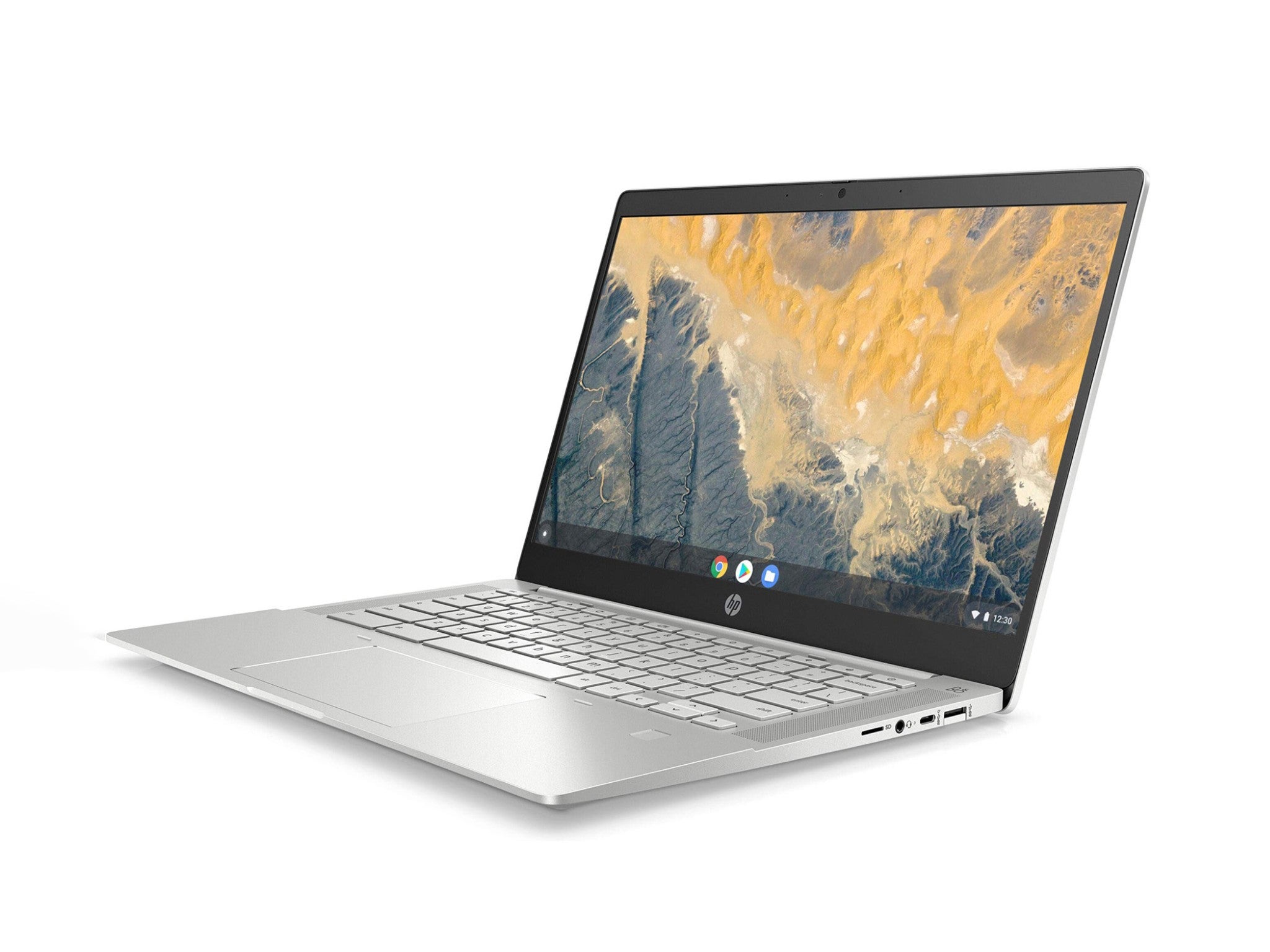
Best: For business users
Rating: 8/10
- CPU: 10th-gen Intel Core i3, i5 or i7 (version tested)
- RAM: 8GB
- Internal storage: 64GB
- GPU: Intel UHD
- Screen: 14in 1920 x 1080
- Weight: 1.5kg
A choice Chromebook cut from HP’s business range, this sleek and professional-looking laptop has everything it takes for all-day use.
The version we’re using has a 10th-generation Intel i7 processor, and is more than capable of tearing through web tasks and just about anything else you ask it to do. The 8GB of RAM helps here, because if there’s one thing Chrome likes, it’s memory to fill up.
The keyboard, despite being squeezed slightly to make space for the B&O-branded speakers each side, feels good under the fingers. As does the trackpad, though this is a little small for our tastes. Key travel and backlighting are nicely judged, while the trackpad’s click is positive, and there’s a good feeling of resistance. There’s a fingerprint sensor at the base of the keyboard, which is nice to see.
The screen is colourful but a little dim, especially if there’s any kind of bright lighting around in your environment. And the speakers? They’re upward firing, so have an advantage in that, and are really nice sounding, for laptop speakers. They’re not going to please hi-fi enthusiasts, but they’ll do when you haven’t got anything else.
Overall, this is one of the best Chromebooks we’ve used. It scores highly for build quality and performance, and while the screen lets it down, especially if you want to use it to enjoy a movie, the whole experience is one of a smoothly operating machine.
Asus Chromebook CX1 (CX1500)
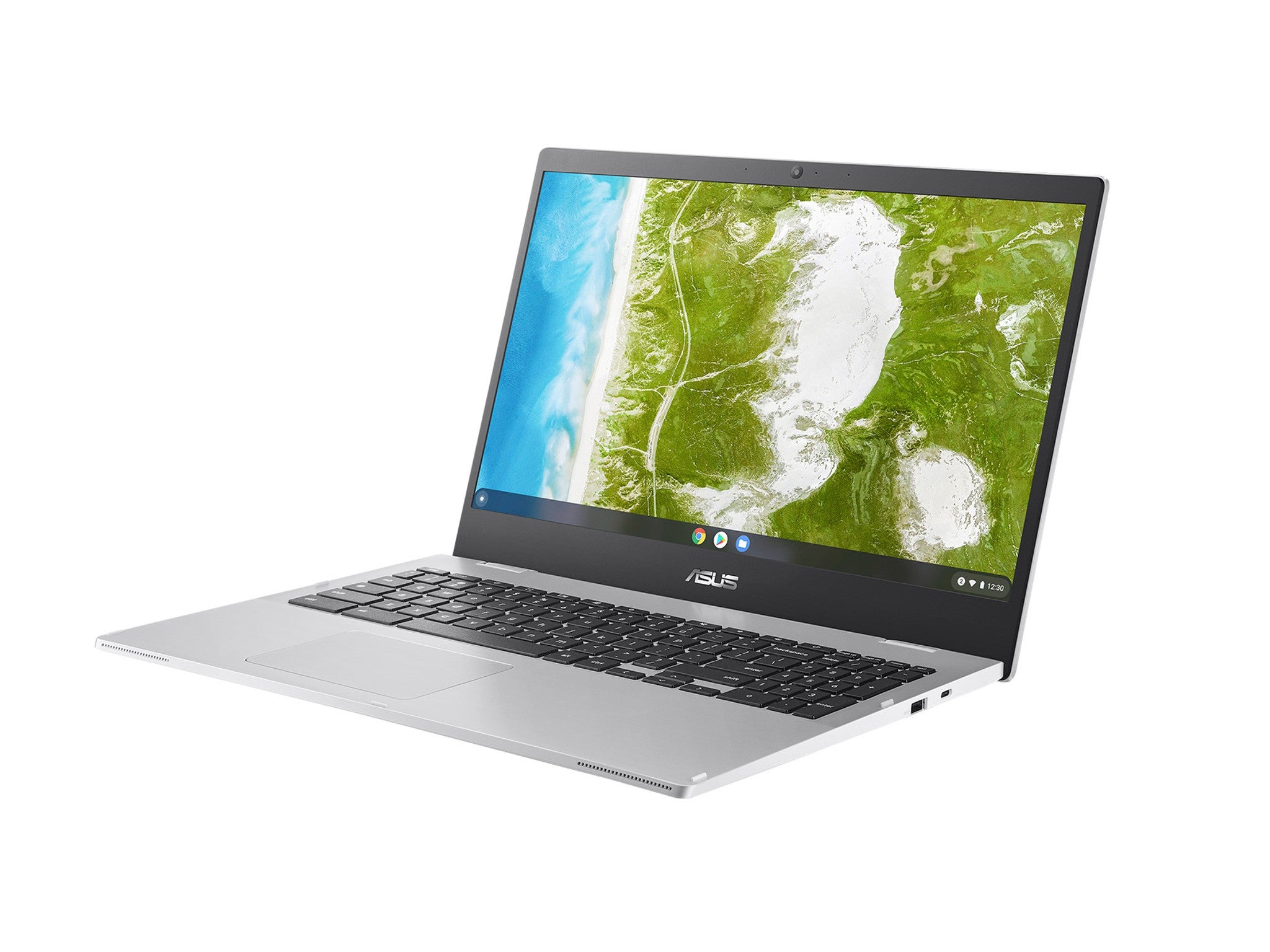
Best: For students
Rating: 6/10
- CPU: Intel Celeron
- RAM: 4GB
- Internal storage: up to 128GB
- GPU: Intel HD
- Screen: 15.6in 1366 x 768
- Weight: 1.8kg
A solid budget choice, let down by a low-resolution screen that’s a bit too dim under strong lighting. ChromeOS is light enough that the 2016-vintage Celeron chip at the heart of this laptop doesn’t struggle too much as you flip windows around, though we can imagine opening particularly large image files might slow it down considerably. However, for browsing, office work and media consumption it does well.
The problem is the screen. It’s LED backlit but dim, at 220 nits, and the model we tested has a resolution of 1280 x 768. There’s a 1920 x 1080 version too, but really this feels like a screen from five years ago. Also showing its age is the graphics processor, which might explain the low resolution of the screen.
Otherwise, we were reasonably impressed with the keyboard – though not the small rectangular enter key, which led to a few mis-presses – while the trackpad fits in with the rest of the body by feeling extremely plasticky. The entire shell of the laptop is plastic, and while this suits its status as a budget model, it’s a little disconcerting to feel the give in the lid when you pick it up. The forward-firing speakers are, naturally, barely adequate, and the selection of ports is standard, with USB type A and C, micro SD, and a headphone jack.
However, it is very cheap, and works just fine as long as you stick to web browsing and gentle office work. We wouldn’t want to drop it off a table, but it fulfils the cheap, low-powered, and cloud-centred Chromebook ideal.
While it’s currently out of stock, you can sign up to be notified when it makes a return.
Acer Chromebook 317

Best: For movie watchers
Rating: 8/10
- CPU: Intel Pentium
- RAM: 4GB
- Internal storage: Up to 128GB
- GPU: Intel UHD
- Screen: 17.3in 1920 x 1080
- Weight: 2.4kg
The world’s first 17.3in Chromebook, apparently, and wow do those extra inches make a difference. We’re sure it won’t be the last. The 17in laptop has been out of favour for a while, as manufacturers have striven to cram components into smaller and smaller bodies, so to have this much space at your disposal feels like luxury.
Admittedly, it’s heavier than others, and you may have to put more thought into which bag you sling it into, but the experience of using the wide 1080p IPS screen and spacious keyboard with space for upward-firing speakers at its sides is not to be underestimated. There’s the usual scattering of USB ports (A and C) plus Micro SD and a headphone socket, and the screen pushes its brightness to 270 nits, which is good enough for streaming but, like so many of the Chromebooks we’ve looked at, isn’t going to stand out on a sunny day.
The CPU may only be a Pentium but it’s a four-core model from 2021, putting it comfortably ahead of any Celeron-equipped Chromebooks on this list. Having the USH graphics chip also helps, and while a bit more RAM would be nice – springing the extra cash for an 8GB model is frequently worth it – we found the 317 to be nicely responsive when browsing, which is what you mostly do with a Chromebook. Plus the extra screen real estate makes all the difference when viewing two windows side by side.
Asus Chromebook CX9
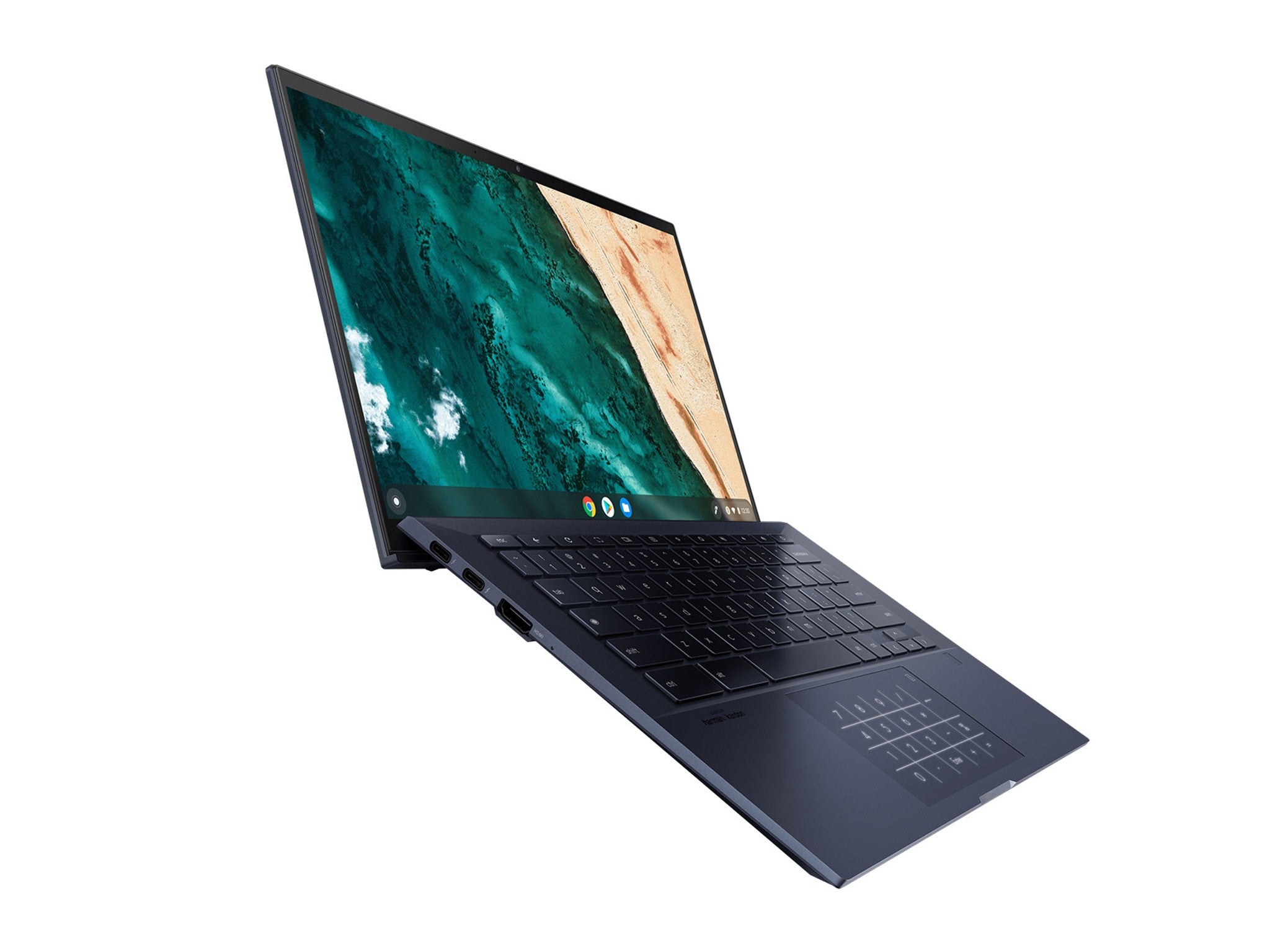
Best: For productivity champions
Rating: 9/10
- CPU: Intel Core i7
- RAM: 16GB
- Internal storage: 512GB
- GPU: Intel Iris Xe
- Screen: 14in 1920 x 1080
- Weight: 1.15kg
Wow, that’s an expensive Chromebook. You could get a MacBook pro for that (just), or a really nice Windows laptop. Whether it’s worth it or not depends on your feelings about the different operating systems – do you want to spend this much for ChromeOS, or would Windows 11 or macOS better suit your needs?
There’s no disputing the strength of its specs, however. Plenty of storage, loads of RAM, an 11th-gen i7 processor with Xe graphics pushing a 1080p screen. It even comes packaged nicely, is extremely light, and has a premium look and feel. There’s a full-size HDMI port too, so you can attach an extra monitor without needing an adapter.
Asus has almost missed the point of Chromebooks here. They’re meant to be browser- and cloud-based, so having that much internal storage seems like overkill. The same goes for the i7 CPU, which combined with the large amount of RAM will mean you can have a lot of browser tabs and apps open at the same time without worrying about slowdown. We appreciate the creation of a “premium” Chromebook, with its bezel-less screen, Harman Kardon speakers, excellent keyboard and wide, glassy trackpad. We just can’t stop thinking about that MacBook pro.
Lenovo 14e chromebook gen 2
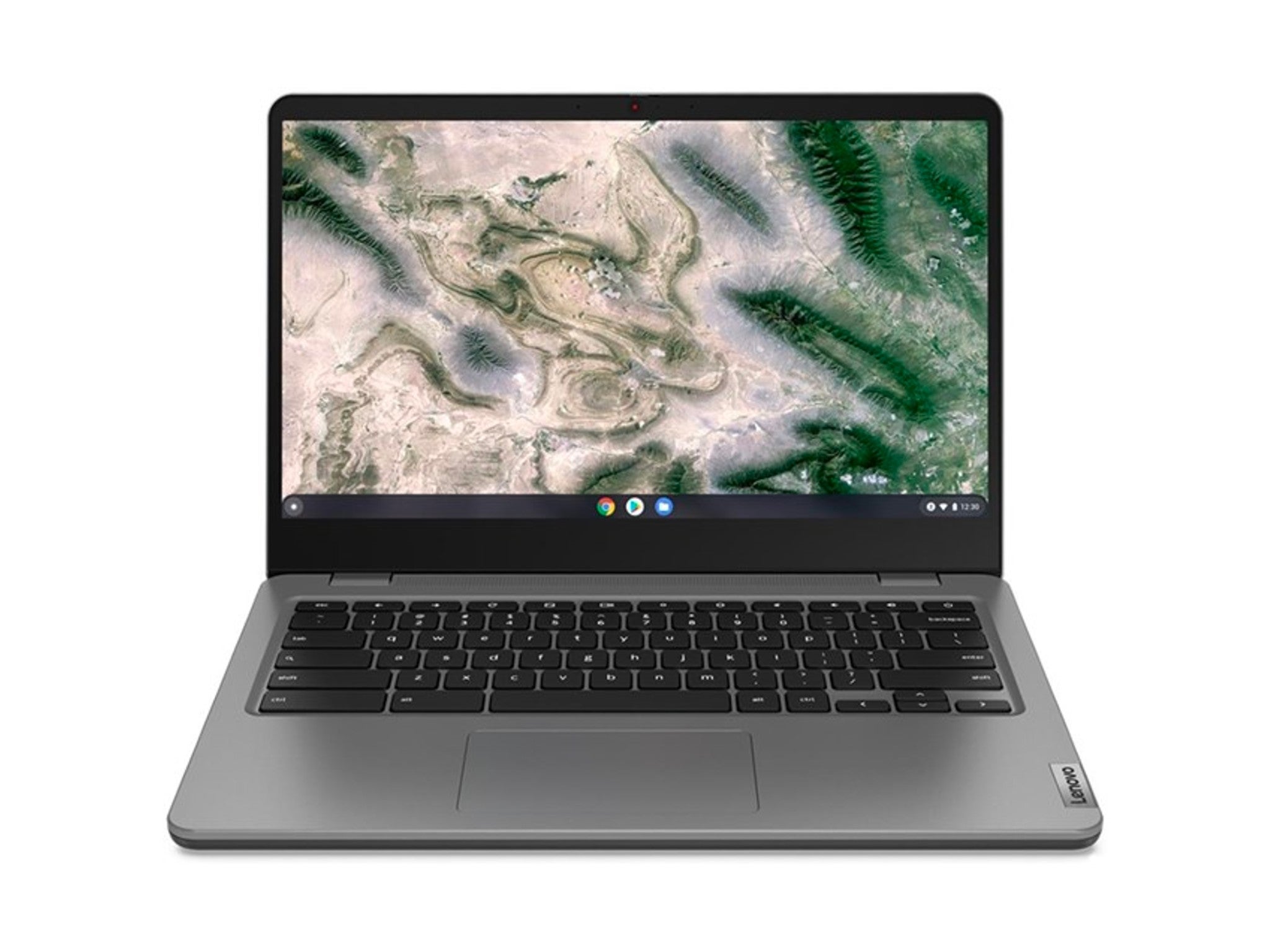
Best: For homework on mountaintops
Rating: 8/10
- CPU: AMD 3015Ce
- RAM: Up to 8GB
- Internal storage: Up to 64GB
- GPU: AMD Radeon integrated
- Screen: 14in 1920 x 1080 (touchscreen optional)
- Weight: 1.45kg
Featuring a rare appearance for an AMD processor in the Chromebook space, the Lenovo 14e is an education-targeted Chromebook with a nice 14in screen and an attractive price, but with no options to expand its internal storage beyond 64GB, is rather reliant on the cloud.
But this is the way of Chromebooks. If you’re using it to complete assignments given out via Google’s online system, and do the necessary research online, then this is really all you need. It’s only when you begin to push up against the edges of its intended use that you might find storage a problem. And you can always slip in a micro SD or attach a flash drive via the useful pair of USB-A ports. Elsewhere, you get a full-size HDMI port, a headphone jack, and a USB-C for charging.
The 14e’s major claim to fame is that it’s tough. It hits the US military’s MIL-STD-810 standard, which means it’s designed to pass lab tests suggesting it can function at high altitude, high and low temperatures, in the sun and rain, when contaminated by fluids, fungus, salt, sand and dust, and stand up to a certain amount of acidity, ballistic shock, and vibration. Of course this doesn’t actually mean they’ve trekked it to the top of a mountain and kicked it off, but if anything’s going to stand up to the rigours of being thrown in a school bag, this is it.
Acer Chromebook spin 713
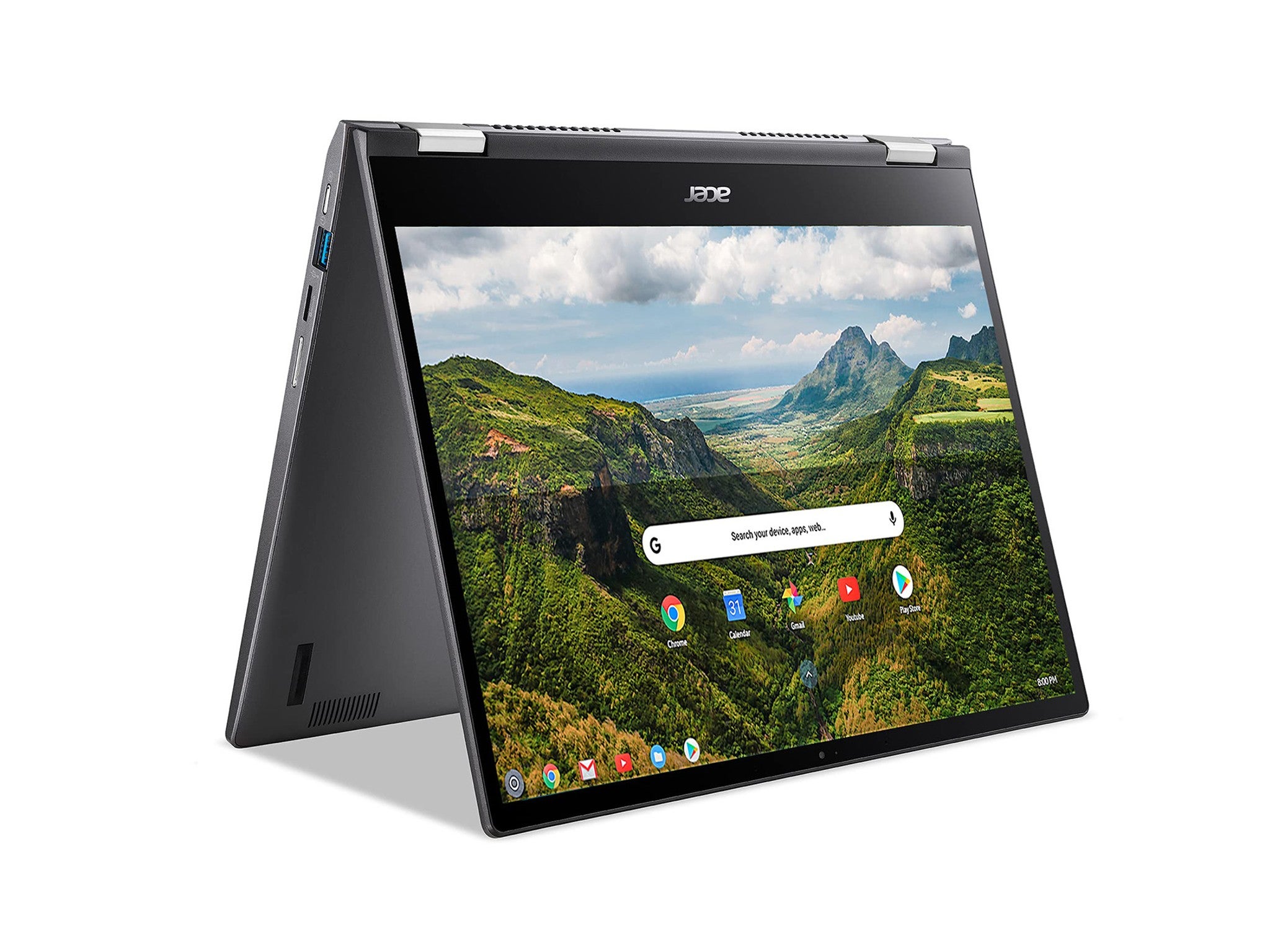
Best: For tablet fans
Rating: 9/10
- CPU: Intel Core i3
- RAM: 8GB
- Internal storage: 256GB
- GPU: Intel UHD
- Screen: 13.5in 2256 x 1504 touchscreen
- Weight: 1.15kg
This is how to do a premium Chromebook. The spin 713 keeps the 11th-gen Intel processor, but drops it to a dual-core i3 with hyperthreading – all you need for a Chromebook. It halves the RAM and storage compared to the Asus CX9, makes the price more reasonable, and both raises the screen’s resolution (changing the aspect ratio to a taller 3:2 as it does so) and makes it a touchscreen.
The result is a revelation. While a folded laptop is never going to be as convenient as a true tablet, the ability to work in different ways, or to sit it standing upright on a table while you watch a movie, the speakers (barely adequate, as usual) firing out of the top of the unit while it’s this way up, makes a huge difference. You can increase the spec if you want, as there’s an i7 option.
There’s a full-size HDMI, and Thunderbolt 4 instead of USB 3.2 powering the Type-C ports for a burst of extra speed. There’s also a lonely Type-A port and a Micro SD slot if you need to expand the storage or plug in your camera memory card.
And while it’s heavier than you’d expect, and the keyboard is a bit soft, there’s no denying that this balance of specs, price, and usability is where Chromebooks should be aiming themselves. It works very nicely, looks good, isn’t going to take up much space, and could well be the only computer you need.
Lenovo 500e chromebook gen 3
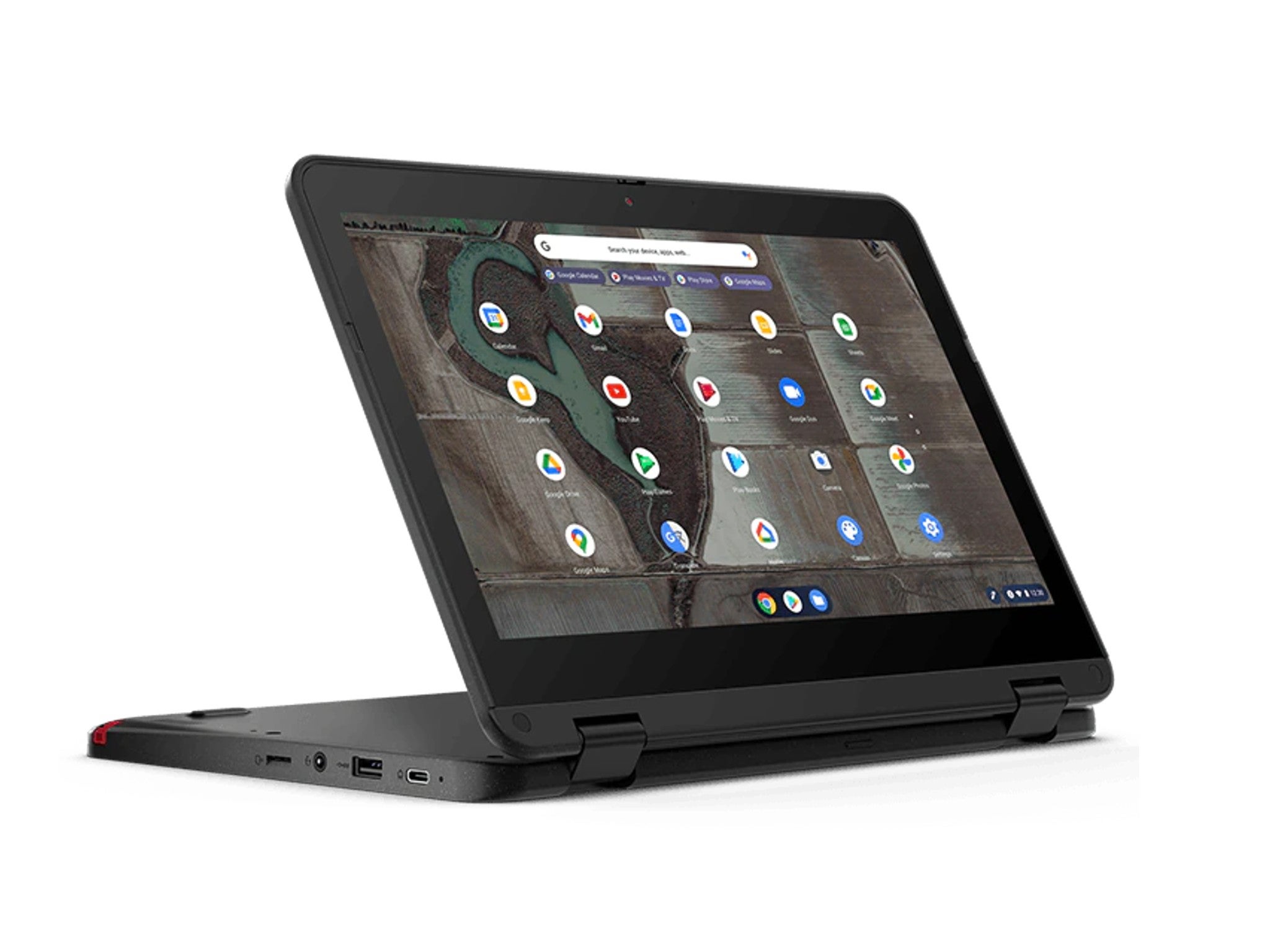
Best: For small spaces
Rating: 7/10
- CPU: Intel Celeron N5100 or Pentium Silver N6000
- RAM: Up to 8GB
- Internal storage: 64GB
- GPU: Intel UHD
- Screen: 11in 1366 x 768 touchscreen Weight: 1.3kg
Small and light are well within the Chromebook’s wheelhouse, and this tiny model from Lenovo really harks back to the netbooks of old. The processor choices are limited, the 64GB of internal storage is tight, but it has a touchscreen, a fine array of external ports, and its own stylus that can be kept inside the casing.
It’s easy to get carried away with laptop processors, assuming that anything not running at least a Core i3 must be hopelessly slow. That’s not true with Chromebooks, where the lightness of the OS means you can get surprising performance out of the smallest of chips. We’d recommend speccing 8GB of RAM, though.
The 500e is a tiny package, but it’s ringed with ports. There’s one USB-C, two USB-A, an HDMI, headphone socket and a micro SD card slot for expanding the storage. The hinge folds through 360 degrees, allowing it to fold back on itself to mimic a tablet or stand up for media playback. The screen, which manages just over 720p resolution, isn’t the greatest for this sort of thing, though at least it uses IPS technology for decent colours and viewing angle. As an extremely portable writing and browsing machine, however, the diminutive 500e acquits itself very nicely.
Chromebook FAQs
No Windows? How do they work?
Chromebooks do have an operating system, it’s just based around Google’s Chrome web browser. This makes it lighter than something like Windows, so it needs lower-powered, cheaper hardware and uses less battery power.
What happens if you go offline?
Not much. You can’t surf the web or back up to the cloud, but with the web apps you need installed on the internal storage, you can carry on as before in the face of spotty wifi. Once you reconnect, your work is synced back to Google Drive so you don’t lose it.
What about security?
ChromeOS is updated approximately every four weeks to fix security problems, and as it can’t run desktop Windows apps or Office macros, you’re less likely to be infected by something nasty that arrives as an email attachment. It’s very important to keep your Google Account password strong and secure, however, as this becomes the key to using both your laptop and the Google Drive backup.
Can I plug in USB drives or my camera?
Most of the time, yes. The internal storage of a Chromebook is often quite small – the idea is to offload your files to Google Drive – so using one might not be ideal if you’re frequently copying large numbers of images off a camera memory card, but they have USB ports and frequently Micro SD card slots, so you can expand your local storage to cope.
What about creative tasks?
Don’t expect to be editing 4K movies, 3D rendering, or running a raw image workflow for a photography studio from a Chromebook, but there are plenty of apps for drawing, photo editing, and other less demanding tasks. Gaming isn’t necessarily off limits either, as there are plenty of Android games a Chromebook can run, and the new game streaming services coming online will suit one perfectly.
Would my office IT department like this?
Some more business-focused Chromebooks come with Chrome Enterprise, which is the same as normal Chrome but with the extra group policies and large-scale deployment capabilities that IT departments like.
The verdict: Chromebooks
Chromebooks took over where netbooks – a short-lived class of really small, low-powered laptops meant for web-browsing and little more – left off. While they can be used without an internet connection, they thrive with one, and the ability to access every file and application you need is a powerful one.
Google just has the edge over Acer in this roundup. The pixelbook go is everything a Chromebook should be, chunky and fun to use, easy to throw in a bag and take with you, and capable enough to do a full day’s work. Its lack of ports may mark it down in some eyes, but it’s nothing an adapter won’t fix.
Acer is still firing very strongly though, with two models that have all the strengths Chromebooks can exhibit. The 317’s screen makes it a titan for media consumption and working with multiple documents, while the 713’s ability to twist its screen back and turn into a pseudo-tablet will mean a lot in the right hands.
The others are, of course, fine. But anyone looking to buy a Chromebook as their only computer besides perhaps a smartphone should put the Google pixelbook go at the top of their list. It hits a spot of price and features that’s particularly sweet.
Voucher codes
For the latest discounts on laptops and tablets, try the links below:
Discover the best internet providers at Independent Advisor
Get the full picture with best laptops of 2022 round-up, whether you’re working from home or gaming on the go

